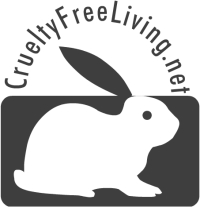Why go cruelty-free?
Countless animals suffer and die -- needlessly -- in labs every day. And what for? As per the Leaping Bunny organization:
"Neither the U.S. Food and Drug Administration (FDA) nor the U.S. Consumer Product Safety Commission require animal testing for cosmetics or household products. There are sufficient existing safety data as well as in vitro alternatives to make animal testing for these products obsolete. While it is true that virtually every ingredient, even water, has been tested on animals in the past, we can help prevent future animal testing."
Going cruelty-free is an easy way to lessen unnecessary suffering in this world. One person really can make a difference when they choose to spend their money on products from companies that put ethics and compassion first.
Watch a short video to learn why going cruelty-free is so important.
How do I know if a product is cruelty-free?
The easiest way is to look for the Leaping Bunny symbol on a product, though not all brands license the logo. To help, Leaping Bunny offers a great app that now features a barcode scanner so you can scan the barcode of any product and learn if it's cruelty-free (available for iPhone and Android devices).
Watch out for any product that uses the language, "Finished product not tested on animals." This means that while the product you are buying in the store may not have been tested, its components have been. A truly cruelty-free product has not commissioned outside testing on ingredients nor tests the finished product on animals.
Be aware of marketing. Just because a company claims to be all-natural, or runs a campaign that encourages women to love their bodies and themselves, or has a cute animal logo, doesn't mean they're cruelty-free. Do your research: Learn about the parent company, where the product is sold and what their policy is on animal testing first.
I'm on a limited budget -- can I afford to go cruelty-free?
Perhaps the myth I hate the most is that going cruelty-free means spending more money -- it's simply not true. Would you believe that my household actually SAVES money now that we're cruelty-free? The inability to impulse purchase as easily as one might have before cruelty-free is gone; I don't just pick up a new lipstick color or nail polish -- I do my research first. Alternatively, not every product I love is carried by all my local stores, so I buy in bulk -- or through a subscription service -- both of which allow me to save money on everything from dish soap to hair spray to toothpaste. Many sites offer coupons and discounts regularly as well.
As with anything, products come in a range of prices. I will do my best to feature things with a range of prices so you can find something that works with your budget.
My local stores don't carry cruelty-free -- where can I buy online?
Having grown up in a small town, I understand that shopping for groceries can mean a 20 minute drive, and searching for cruelty-free deodorant might mean an additional trip across town. Thankfully, we have the internet!
CrueltyFreeConsumer.com, Soap.com and Amazon are just a few of my favorite online resources. Target -- online and in stores -- has begun to offer natural and organic products. While "natural" and "organic" doesn't necessarily mean something is cruelty-free, this category offers Alba Botanica, Burt's Bees, Jason and J.R. Watkins, among other brands.
A product claims to be cruelty-free, except where animal testing is required by law. What does this mean?
This is a company's way of trying to appear blameless in a situation driven by greed. Language like this is common with many major makeup brands that sell in China, where animal testing is required by law. These brands pay for animal suffering so they can make a profit. If a product -- beauty or home -- is sold in China, it's not cruelty-free.
Help! I just went through the products in my house and many are not cruelty-free. What do I do?
First of all, don't panic. Take a deep breath. It can be a bit of a shock to realize just how common animal testing is in this day and age, but you've made the first big step by deciding to change your buying habits.
Not everyone can afford to just throw away everything that isn't cruelty-free (and in my opinion, pretty wasteful to do so, though not everyone may agree). See what you're going to run out of first and make a plan of action. Decide what brand you're going to try, where you can buy it, and either order it and have it ready for when you need a new product, or be prepared to take a trip to the store. If you aren't using a product, or want to make the switch immediately, be sure to dispose of the product responsibly (that means getting rid of chemicals safely and recycling packaging). This is a process that may take some time, but before you know it, it will become second nature.

